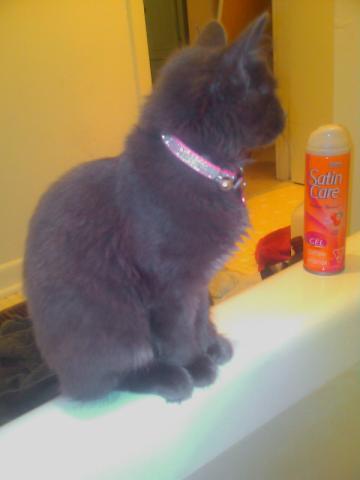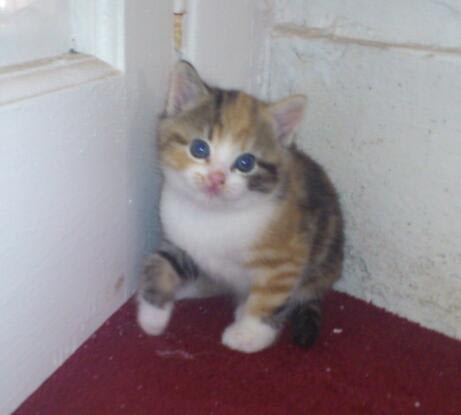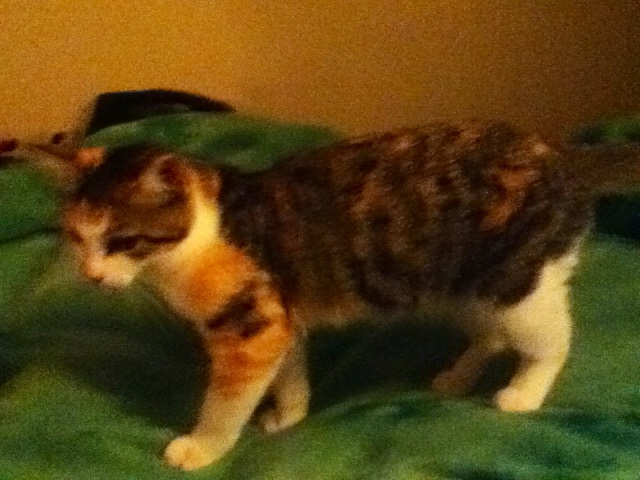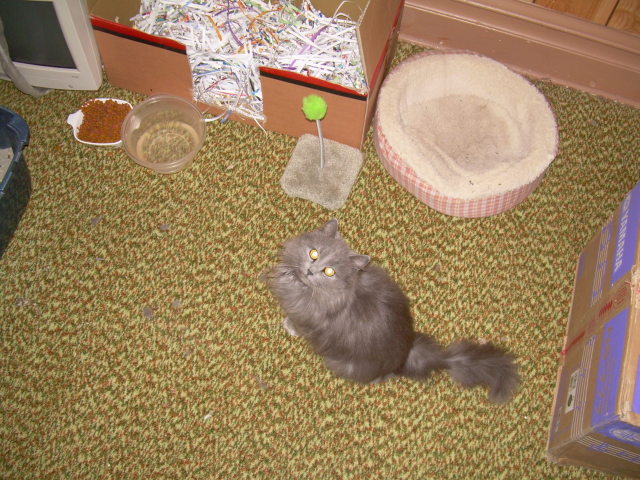Questionhow long are they usually in labor their first time? how many do they normaly have their first time?
AnswerMelissa,
The length of labor will depend upon the age of the queen and her overall condition. From the very beginning of labor until the point when all of the kittens have been delivered can be 12+ hours. On average the pushing phase and actual delivery of the kittens can last several hours. If you know approximately when your cat became pregnant you will have an idea of when to expect the new arrivals. The gestation period for cats is roughly 60-68 days. Its not uncommon to see changes in appetite and a decrease in activity towards the end of the pregnancy.
If you think that mom has been in labor for 24 hours without showing signs of progressing and delivering kittens she needs medical attention. Its important to act promptly if you suspect that something may be going wrong for mom or her kittens during labor and delivery. If you think that mom may be having difficulty with her labor and shes already given birth to one or more kittens then you should take her to the veterinarian immediately, be sure to bring any newborn kittens to the vet with you so that they can stay with their mother.
Sometimes a cats labor can stall for a variety of reasons, in the majority of these cases vets will place an IV catheter to provide mom with fluids and essential energy to continue with her labor and watch her over a few hours to see whether or not her labor starts up again to deliver the kittens on her own. Many queens who deliver their kittens vaginally will eat the placenta, this is perfectly normal and provides some extra nutrition to help mom through the rest of her labor. If mom isnt able to deliver her kittens vaginally the vet will perform a caesarian.
In the event that your cats litter must be delivered by caesarian the newborn kittens will be affected by the anesthesia their mother received during the surgery so it may take them longer to start breathing on their own. Your vet may have a veterinary technician pass kittens on to you to be dried off and helping to stimulate breathing by rubbing the newborns vigorously. There is a slightly higher rate of complications for kittens delivered by caesarian because they didnt have fluids squeezed out of their airway as they were being born. The reality is that some kittens delivered by caesarian dont survive, however the majority do just fine.
An average sized litter of kittens is anywhere from 3-8, although there's no way to know how many babies to expect or the approximate due date without having the vet do an x-ray or ultrasound most first time mothers tend to have litters on the smaller end of normal. Most cats have no difficulty delivering a healthy litter of kittens, however there are instances where complications arise that require medical intervention. Its best to try and maintain distance and allow mom some privacy to give birth on her own. If things are noisy and theres lots of activity happening theres a possibility that moms labor will stall. You may be tempted to take pictures or assist in the delivery, but unless there are complications its important to allow nature to take its course.
Ive taken the liberty of including some important information about caring for a litter of kittens and nursing queen. Caring for a litter of kittens and nursing mom properly can be expensive and time consuming. Ideally mom should be eating as much as she wants of a high quality holistic cat food made from human grade ingredients, this will allow mom to get the nutrition she needs to support her rapidly growing kittens and meet her own needs. Newborn kittens are born with very little resistance to infections and they're unable to maintain their own body temperature which means that they should really be born and cared for indoors. It's a good idea to set up an appropriately sized nesting box lined with some old towels or a blanket immediately if you havent done so already. There is a good chance that mom may not accept a nesting box since shes so close to delivery, but after the little ones are born mom may allow the family to be transferred into this box. I recommend placing the nesting box in a room that's climate controlled, quiet and dimly lit.
Mother cats prefer to give birth to their offspring quietly and privately. It's best not to interfere with the labor and birth process unless its absolutely necessary to deal with medical emergencies. Its important not to have too much noise or traffic in and out of the room when mom is delivering her kittens because stress can cause the labor to stall which could require treatment by a vet to start things rolling again or your cat may even require a caesarian.
It's not a bad idea to keep a close eye on mom once she starts showing signs of labor so that you have a general idea of how things are progressing. Signs of imminent labor can include pacing, meowing, anxiety, panting and trying to nest. Once mom begins the pushing phase of labor things should progress fairly quickly, it's perfectly normal for mom to issue some fairly dramatic yowls during the course of delivering her kittens, especially since if this is her first litter.
If mom pushes for longer than an hour without producing a kitten she should be taken to the vet immediately because this is a fairly reliable indication that a kitten is in the wrong position for delivery or too large to fit through moms pelvis. The vet can help your cat by assisting her with a vaginal delivery or performing a caesarian section. Your veterinarian will decide on the best course of action for the wellbeing of mom and her babies.
If you see that mom has a dark greenish discharge from her vagina during the delivery it could indicate that the placentas are separating prematurely, its best to take the mom and any newborn kittens to see a vet promptly in this situation. If your cat has a large litter or she's a fairly small cat she may develop eclampsia which is a dangerous calcium/magnesium deficiency. Some possible indications that your cat may have eclampsia include a stilted gait, anxiety or seizures in the later stages. If you have any concerns that your cat may have eclampsia she should be taken to the nearest vet for treatment immediately.
Kittens should ideally stay with their mother until they are at least 12 weeks of age. Mother cats DO NOT require human assistance to wean their kittens, they will do so on their own typically within the first 10-12 weeks of life. During the first 12 weeks of life kittens become stronger, more active and they begin the process of socialization. Newborn kittens are born with very soft bones and they stay that way for the first several weeks of life.
Young kittens placed into adoptive homes prior to 12 weeks of age can have a higher chance of accidental injuries because their bones are quite soft and growing rapidly. In the first several weeks of life kittens are quite vulnerable to viral and bacterial infections so it's important to keep mom and her kittens separated from other pets in the household and anyone handling the mother or her kittens should wash their hands thoroughly in hot, soapy water prior to handling the little family.
Female cats can become pregnant fairly quickly after giving birth so it's best to keep mom inside at all costs once she's given birth to avoid anymore unwanted litters. It's important to thoroughly clean and disinfect the family's food and water dishes daily using a weak bleach solution (5 parts water, 1 part bleach), the same bleach solution should be used to disinfect the litter trays that mom and her kittens have access to on a weekly basis. Having at least one kitten sized litter pan available in the room that mom is raising her babies in is important, mom will begin potty training her kittens earlier than most people think. Any bedding in the nursery box should be changed promptly if it becomes wet or soiled, this will help to keep the kittens clean and warm.
The first several weeks of life are crucial in terms of socializing kittens so it's important to handle the kittens gently and frequently so that they become comfortable with people. If at all possible having people of different age groups and genders handling the kittens is the best possible way of socializing young kittens, just be sure that everyone takes the appropriate hygienic precautions until the kittens are old enough to be placed in adoptive homes.
In view of the serious pet overpopulation issue affecting shelters and rescue organizations worldwide I usually recommend that pet parents spay or neuter their pets before sexual maturity to avoid accidental pregnancies. There are far too many healthy, adoptable cats and kittens that are unwanted which isnt a good situation for pet lovers or the cats. Many healthy, adoptable cats and kittens are euthanized worldwide every year just because they arent wanted - the shelters and rescue groups just don't have the space, time, or finances to keep every unwanted cat that comes in the door until someone comes along to offer them a permanent home.
It is a commonly held belief that female cats should have at least one litter of kittens prior to being spayed in order for them to become calmer. Unfortunately what many people don't realize is that many female cats become pregnant around the time that they would normally begin to settle down anyway. Choosing to spay or neuter household pets is responsible, ethical and its a decision that saves countless lives each year.
There are several medical and behavioral benefits to spaying and neutering cats. Cats who have been sterilized are far less likely to develop serious behavioral problems which can lead to euthanasia such as house soiling, fighting or being aggressive with cats/people when defending their territory. This is significant because the number one cause of death in North American cats is euthanasia secondary to behavioral problems.
The medical benefits to spaying/neutering a cat include a reduced risk of prostate/mammary cancers, preventing testicular, ovarian or uterine cancers. Female cats that haven't been spayed have a substantially increased risk of developing breast cancer or mastitis (a painful infection of the mammary glands). An infection of the uterus called pyometra affects intact female cats, this infection causes the womb to fill with pus - if left untreated the uterus can rupture spreading infection throughout the abdomen almost certainly causing death or this serious infection can simply overwhelm the cat's system.

 urgent cat problem
Question
kitty aka chanel
my cat is about 7 mont
urgent cat problem
Question
kitty aka chanel
my cat is about 7 mont
 Is my kitten counted as a male calico?
QuestionQUESTION: I have a new litter of kittens and th
Is my kitten counted as a male calico?
QuestionQUESTION: I have a new litter of kittens and th
 is my male kitten a tortoiseshell?
Question
our wee guy our wee guy
Hi,
I am
is my male kitten a tortoiseshell?
Question
our wee guy our wee guy
Hi,
I am
 Short Tailed Manx Kitten
Question
Una Mica Una Mica
Hello,
I go
Short Tailed Manx Kitten
Question
Una Mica Una Mica
Hello,
I go
 How pregnant is my cat
QuestionQUESTION: I was adopted by a local neighbor hoo
How pregnant is my cat
QuestionQUESTION: I was adopted by a local neighbor hoo